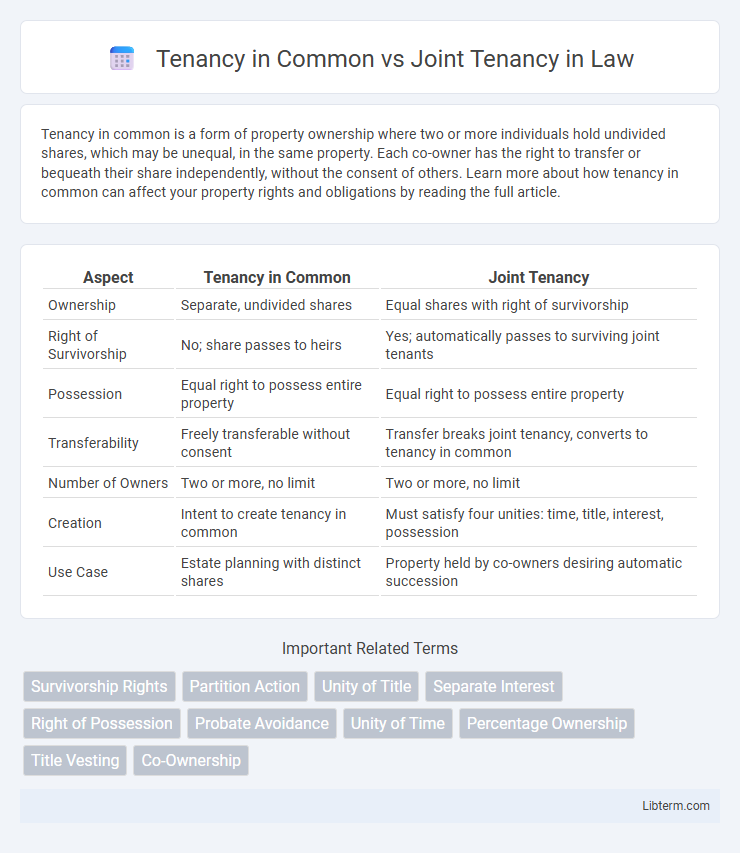Tenancy in common is a form of property ownership where two or more individuals hold undivided shares, which may be unequal, in the same property. Each co-owner has the right to transfer or bequeath their share independently, without the consent of others. Learn more about how tenancy in common can affect your property rights and obligations by reading the full article.
Table of Comparison
| Aspect | Tenancy in Common | Joint Tenancy |
|---|---|---|
| Ownership | Separate, undivided shares | Equal shares with right of survivorship |
| Right of Survivorship | No; share passes to heirs | Yes; automatically passes to surviving joint tenants |
| Possession | Equal right to possess entire property | Equal right to possess entire property |
| Transferability | Freely transferable without consent | Transfer breaks joint tenancy, converts to tenancy in common |
| Number of Owners | Two or more, no limit | Two or more, no limit |
| Creation | Intent to create tenancy in common | Must satisfy four unities: time, title, interest, possession |
| Use Case | Estate planning with distinct shares | Property held by co-owners desiring automatic succession |
Understanding Tenancy in Common
Tenancy in Common allows multiple owners to hold individual, undivided ownership interests in a property, which can be unequal and freely transferable. Each tenant in common has the right to sell, mortgage, or will their share independently, without the consent of other co-owners. This form of ownership offers flexibility compared to Joint Tenancy, which includes the right of survivorship and requires equal ownership shares.
What is Joint Tenancy?
Joint Tenancy is a form of property ownership where two or more individuals hold equal shares with rights of survivorship, meaning when one owner dies, their share automatically passes to the surviving co-owners. This type of ownership requires the four unities of possession, interest, time, and title to be valid. Joint Tenancy is commonly used among spouses or close family members to ensure seamless transfer of property without probate.
Key Differences Between Tenancy in Common and Joint Tenancy
Tenancy in common allows multiple owners to hold individual, divisible shares of a property, which can be unequal and transferred independently through sale or inheritance. Joint tenancy features equal ownership shares with the right of survivorship, meaning upon the death of one owner, their interest automatically passes to the surviving joint tenants. Key differences include the ability to transfer ownership interests without consent in tenancy in common versus the survivorship rights and equal shares that characterize joint tenancy.
Ownership Structure and Rights
Tenancy in Common allows multiple owners to hold individual, undivided shares in a property, each with the right to sell or transfer their interest independently. Joint Tenancy includes a right of survivorship, where co-owners hold equal shares and ownership automatically passes to surviving tenants upon death. The ownership structure in Joint Tenancy creates a unified interest, while Tenancy in Common permits flexible, distinct ownership percentages and separate inheritance rights.
Survivorship Rules Explained
Tenancy in Common allows co-owners to hold individual shares that can be sold or inherited independently, with no right of survivorship; upon a co-owner's death, their share passes according to their will or state law. Joint Tenancy includes the right of survivorship, meaning when one co-owner dies, their interest automatically transfers to the surviving joint tenants, bypassing probate. Understanding these survivorship rules is crucial for estate planning and property rights management.
How to Create a Tenancy in Common or Joint Tenancy
To create a tenancy in common or joint tenancy, parties must clearly specify the type of co-ownership in the property deed or title at the time of purchase. For joint tenancy, the deed must include the right of survivorship clause, ensuring that upon a co-owner's death, their share automatically transfers to the surviving owners. In contrast, tenancy in common requires each co-owner to have a separate, divisible interest without right of survivorship, allowing owners to sell or bequeath their share independently.
Pros and Cons of Tenancy in Common
Tenancy in Common offers flexible ownership where each tenant holds an individual, divisible share that can be sold or bequeathed independently, providing greater control over property interests. However, the lack of survivorship rights means that upon a co-owner's death, their share does not automatically pass to the other co-owners but is subject to probate, potentially complicating property succession. This arrangement allows for unequal ownership percentages but may lead to conflicts or difficulties in decision-making without unanimous consent among co-owners.
Pros and Cons of Joint Tenancy
Joint Tenancy offers the advantage of automatic survivorship, meaning the property directly passes to surviving co-owners without probate, which can simplify estate planning and reduce legal costs. However, Joint Tenancy requires all owners to have equal shares and unity of possession, limiting flexibility in ownership transfers and complicating situations where co-owners wish to sell or mortgage their interest independently. A significant drawback is the risk of unintended consequences if one owner faces legal or financial troubles, as their share could be forcibly sold, impacting all joint tenants.
Choosing the Right Ownership for Your Situation
Choosing between Tenancy in Common and Joint Tenancy depends on your goals for property ownership, inheritance, and control. Tenancy in Common allows multiple owners to hold unequal shares and pass their interest through a will, making it suitable for investors or unrelated co-owners. Joint Tenancy features equal ownership with rights of survivorship, ideal for spouses or partners seeking automatic transfer of property upon death without probate.
Frequently Asked Questions About Property Co-Ownership
Tenancy in Common allows co-owners to hold unequal shares and transfer their interest independently, while Joint Tenancy requires equal shares with the right of survivorship, meaning property automatically passes to surviving owners. Common questions about property co-ownership often include how each form affects inheritance, tax implications, and the process for selling one's share. Understanding these differences is crucial for co-owners to protect their rights and plan estate transfers effectively.
Tenancy in Common Infographic

 libterm.com
libterm.com